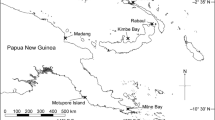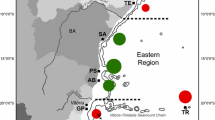Abstract
Many cnidarians (e.g., corals, octocorals, sea anemones) maintain a symbiosis with dinoflagellates (zooxanthellae). Zooxanthellae are grouped into clades, with studies focusing on scleractinian corals. We characterized zooxanthellae in 35 species of Caribbean octocorals. Most Caribbean octocoral species (88.6%) hosted clade B zooxanthellae, 8.6% hosted clade C, and one species (2.9%) hosted clades B and C. Erythropodium caribaeorum harbored clade C and a unique RFLP pattern, which, when sequenced, fell within clade C. Five octocoral species displayed no zooxanthella cladal variation with depth. Nine of the ten octocoral species sampled throughout the Caribbean exhibited no regional zooxanthella cladal differences. The exception, Briareum asbestinum, had some colonies from the Dry Tortugas exhibiting the E. caribaeorum RFLP pattern while elsewhere hosting clade B. In the Caribbean, octocorals show more symbiont specificity at the cladal level than scleractinian corals. Both octocorals and scleractinian corals, however, exhibited taxonomic affinity between zooxanthella clade and host suborder.

Similar content being viewed by others
References
Baker AC (1999) The symbiosis ecology of reef-building corals. University of Miami, Coral Gables, Florida, USA (120)
Baker AC (2001) Reef corals bleach to survive change. Nature 411:765–766
Baker AC (2003) Flexibility and specificity in coral-algal symbiosis: diversity, ecology, and biogeography of Symbiodinium. Ann Rev Ecol Syst 34:661–689
Baker AC, Rowan R (1997) Diversity of symbiotic dinoflagellates (zooxanthellae) in scleractinian corals of the Caribbean and Eastern Pacific. Proceedings of the Eighth International Coral Reef Symposium, Panama 2:1301–1306
Baker AC, Rowan R, Knowlton N (1997) Symbiosis ecology of two Caribbean acroporid corals. Proceedings of the Eighth International Coral Reef Symposium, Panama 2:1295–1300
Billinghurst Z, Douglas AE, Trapido-Rosenthal HG (1997) On the genetic diversity of the symbiosis between the coral Montastraea cavernosa and zooxanthellae in Bermuda. Proceedings of the Eighth International Coral Reef Symposium, Panama 2:1291–1294
Blank RJ (1987) Cell architecture of the dinoflagellate Symbiodinium sp. inhabiting the Hawaiian stony coral Montipora verrucosa. Mar Biol 94:143–155
Coffroth MA, Santos SR, Goulet TL (2001) Early ontogenetic expression of specificity in a cnidarian-algal symbiosis. Mar Ecol Prog Ser 222:85–96
Darius HT, Dauga C, Grimont PAD, Chungue E, Martin PMV (1998) Diversity in symbiotic dinoflagellates (Pyrrhophyta) from seven scleractinian coral species: restriction enzyme analysis of small subunit ribosomal RNA genes. J Eukaryotic Microbiol 45:619–627
Diekmann OE, Bak RPM, Tonk L, Stam WT, Olsen JL (2002) No habitat correlation of zooxanthellae in the coral genus Madracis on a Curaçao reef. Mar Ecol Prog Ser 227:221–232
Goldberg WM (1973) The ecology of the coral-octocoral communities off the southeast Florida coast: geomorphology, species composition, and zonation. Bull Mar Sci 23:465–488
Goulet TL, Coffroth MA (2003a) Genetic composition of zooxanthellae between and within colonies of the octocoral Plexaura kuna, based on small subunit rDNA and multilocus DNA fingerprinting. Mar Biol 142:233–239
Goulet TL, Coffroth MA (2003b) Stability of an octocoral-algal symbiosis over time and space. Mar Ecol Prog Ser 250:117–124
Kinzie RA III (1973) The zonation of West Indian gorgonians. Bull Mar Sci 23:93–154
Kinzie RA III (1974) Plexaura homomalla: the biology and ecology of a harvestable marine resource. Stud Trop Oceanogr Miami 12:22–28
Kinzie RA III, Chee GS (1982) Strain-specific differences in surface antigens of symbiotic algae. Appl Environ Microbiol 44:1238–1240
LaJeunesse TC (2001) Investigating the biodiversity, ecology, and phylogeny of endosymbiotic dinoflagellates in the genus Symbiodinium using the ITS region: In search of a “species” level marker. J Phycol 37:866–880
LaJeunesse TC (2002) Diversity and community structure of symbiotic dinoflagellates from Caribbean coral reefs. Mar Biol 141:387–400
LaJeunesse TC, Loh W, van Woesik R, Hoegh-Guldberg O, Schmidt GW, Fitt WK (2003) Low symbiont diversity in southern Great Barrier Reef corals, relative to those of the Caribbean. Limnol Oceanogr 48:2046–2054
Lang JC, Lasker HR, Gladfelter EH, Hallock P, Jaap WC, Losada FJ, Muller RG (1992) Spatial and temporal variability during periods of “recovery” after mass bleaching on Western Atlantic coral reefs. Am Zool 32:696–706
Lasker HR, Coffroth MA (1983) Octocoral distributions at Carrie Bow Cay, Belize. Mar Ecol Prog Ser 13:21–28
Lasker HR, Peters EC, Coffroth MA (1984) Bleaching of reef coelenterates in the San Blas Islands, Panama. Coral Reefs 3:183–190
Loh WKW, Loi T, Carter D, Hoegh-Guldberg O (2001) Genetic variability of the symbiotic dinoflagellates from the wide ranging coral species Seriatopora hystrix and Acropora longicyathus in the Indo-West Pacific. Mar Ecol Prog Ser 222:97–107
Muzik K (1982) Octocorallia (Cnidaria) from Carrie Bow Cay, Belize. Smithsonian Contrib Mar Sci 12:303–310
Rodriguez-Lanetty M, Loh W, Carter D, Hoegh-Guldberg O (2001) Latitudinal variability in symbiont specificity within the widespread scleractinian coral Plesiastrea versipora. Mar Biol 138:1175–1181
Rowan R (1998) Diversity and ecology of zooxanthellae on coral reefs. J Phycol 34:407–417
Rowan R, Knowlton N (1995) Intraspecific diversity and ecological zonation in coral-algal symbiosis. Proceedings of the National Academy of Sciences of the United States of America 92:2850–2853
Rowan R, Knowlton N, Baker A, Jara J (1997) Landscape ecology of algal symbionts creates variation in episodes of coral bleaching. Nature 388:265–269
Rowan R, Powers DA (1991a) A molecular genetic classification of zooxanthellae and the evolution of animal-algal symbiosis. Science 251:1348–1351
Rowan R, Powers DA (1991b) Molecular genetic identification of symbiotic dinoflagellates (zooxanthellae). Mar Ecol Prog Ser 71:65–73
Rowan R, Powers DA (1992) Ribosomal RNA sequences and the diversity of symbiotic dinoflagellates (zooxanthellae). Proceedings of the National Academy of Sciences of the United States of America 89:3639–3643
Sadler LA, McNally KL, Govind NS, Brunk CF, Trench Rk (1992) The nucleotide sequence of the small subunit ribosomal RNA gene from Symbiodinium pilosumm a symbiotic dinoflagellate. Curr Genet 21:409–416
Sanchez J, Diaz J, Zea S (1997) Gorgonian communities in two contrasting environments on oceanic atolls of the Southwestern Caribbean. Bull Mar Sci 61:453–465
Santos SR, Taylor DJ, Coffroth MA (2001) Genetic comparisons of freshly isolated versus cultured symbiotic dinoflagellates: implications for extrapolating to the intact symbiosis. J Phycol 37:900–912
Santos SR, Taylor DJ, Kinzie RAI, Hidaka M, Sakai K, Coffroth MA (2002) Molecular phylogeny of symbiotic dinoflagellates inferred from partial chloroplast large subunit (23S)-rDNA sequences. Molec Phylogen Evol 23:97–111
Santos SR, Gutierrez-Rodriguez C, Coffroth MA (2003a) Phylogenetic identification of symbiotic dinoflagellates via length heteroplasmy in domain V of chloroplast large subunit (cp23S)-ribosomal DNA sequences. Mar Biotechnol 5:1–11
Santos SR, Gutierrez-Rodriguez C, Coffroth MA (2003b) Symbiodinim sp. associations in the gorgonian Pseudopterogorgia elisabethae in the Bahamas: high levels of genetic variability and population structure in symbiotic dinoflagellates. Mar Biol 143:111–120
Santos SR, Shearer TL, Hannes AR, Coffroth MA (2004) Fine-scale diversity and specificity in the most prevalent lineage of symbiotic dinoflagellates (Symbiodinium, Dinophyceae) of the Caribbean. Molecular Ecology 13:459–469
Swofford D (1998) PAUP*. Phylogenetic Analysis Using Parsimony (*and other methods). Sinauer Associates, Sunderland (128)
Toller WW, Rowan R, Knowlton N (2001a) Repopulation of zooxanthellae in the Caribbean corals Montastraea annularis and M. faveolata following experimental and disease-associated bleaching. Biol Bull 201:360–373
Toller WW, Rowan R, Knowlton N (2001b) Zooxanthellae of the Montastraea annularis species complex: patterns of distribution of four taxa of Symbiodinium on different reefs and across depths. Biol Bull 201:348–359
Toller WW, Rowan R, Knowlton N (2002) Genetic evidence for a protozoan (phylum Apicomplexa) associated with corals of the Montastraea annularis species complex. Coral Reefs 21:143–146
Trench RK (1993) Microalgal-invertebrate symbioses: a review. Endocytobiosis and Cell Research 9:135–175
Trench RK (1997) Diversity of symbiotic dinoflagellates and the evolution of microalgal-invertebrate symbioses. Proceedings of the Eighth International Coral Reef Symposium, Panama 2:1275–1286
van Oppen MJH, Palstra FP, Piquet AMT, Miller DJ (2001) Patterns of coral-dinoflagellate associations in Acropora: significance of local availability and physiology of Symbiodinium strains and host-symbiont selectivity. Proc R Soc Lond B 268:1759–1767
Wilcox TP (1997) The evolution of algal-invertebrate symbioses. University of Houston, Houston, Texas, USA (123)
Wilcox TP (1998) Large-subunit ribosomal RNA systematics of symbiotic dinoflagellates: morphology does not recapitulate phylogeny. Molec Phylogen Evol 10:436–448
Williams EH Jr, Bunkley-Williams L (1990) The world-wide coral reef bleaching cycle and related sources of coral mortality. Atoll Res Bull 335:1–71
Zar JH (ed) (1984) Biostatistical analysis. Prentice-Hall, Englewood Cliffs (718)
Acknowledgements
We thank E. Beiring, D. Goulet, H. Lasker, S. Santos, and T. Swain for assistance in the field. A special thank you goes to E. Beiring, D. Brazeau, H. Lasker and S. McKenna, for providing some of the samples. We are especially grateful to Juan Sanchez for his expertise and assistance in identifying the octocorals. We are grateful to R. Rowan for providing the Symbiodinium clonal standards and T. Shearer for primer and cnidarian sequences. We thank the Republic of Panama and the Kuna Indians for permission to work in the San Blas Islands, and the staff and scientists of the Smithsonian Tropical Research Institute, particularly N. Knowlton, for their assistance. This work was supported by the American Museum of Natural History, Lerner Gray Fund for Marine Research; Houston Underwater Club, Seaspace Scholarship; Mark Diamond Research Fund; PADI Foundation; Sigma ** Society, Grant-in-Aid of Research; and a Smithsonian Tropical Research Institute, Short-Term Fellowship to TLG; NOAA (NURP) grant NA16RU1496 to University of Mississippi (G. Gaston, P.I.); and NSF grant OCE9530057 to MAC.
Author information
Authors and Affiliations
Corresponding author
Additional information
Communicated by R.C. Carpenter
Rights and permissions
About this article
Cite this article
Goulet, T.L., Coffroth, M.A. The genetic identity of dinoflagellate symbionts in Caribbean octocorals. Coral Reefs 23, 465–472 (2004). https://doi.org/10.1007/s00338-004-0408-8
Received:
Accepted:
Published:
Issue Date:
DOI: https://doi.org/10.1007/s00338-004-0408-8




